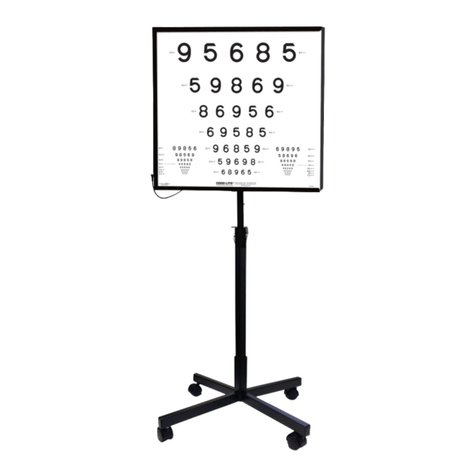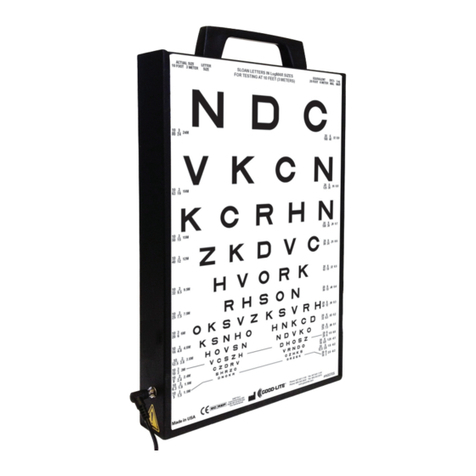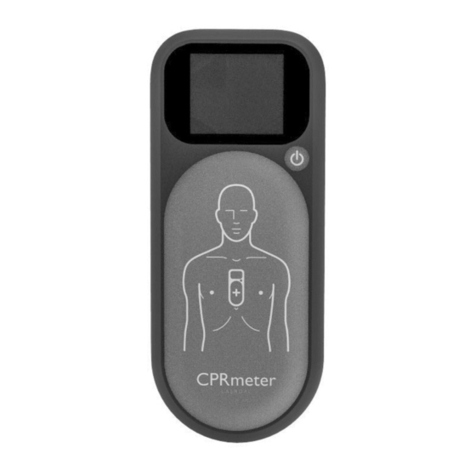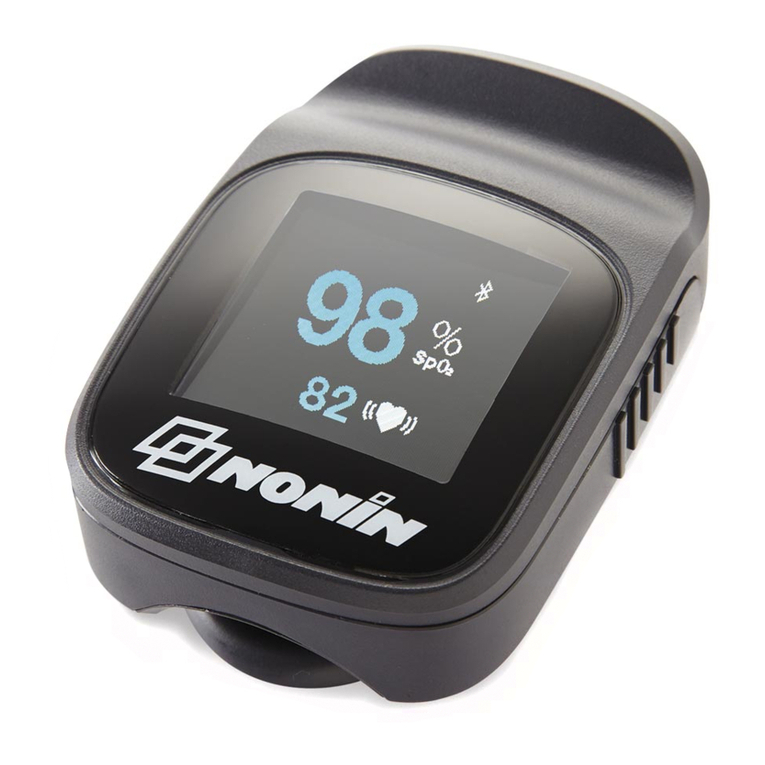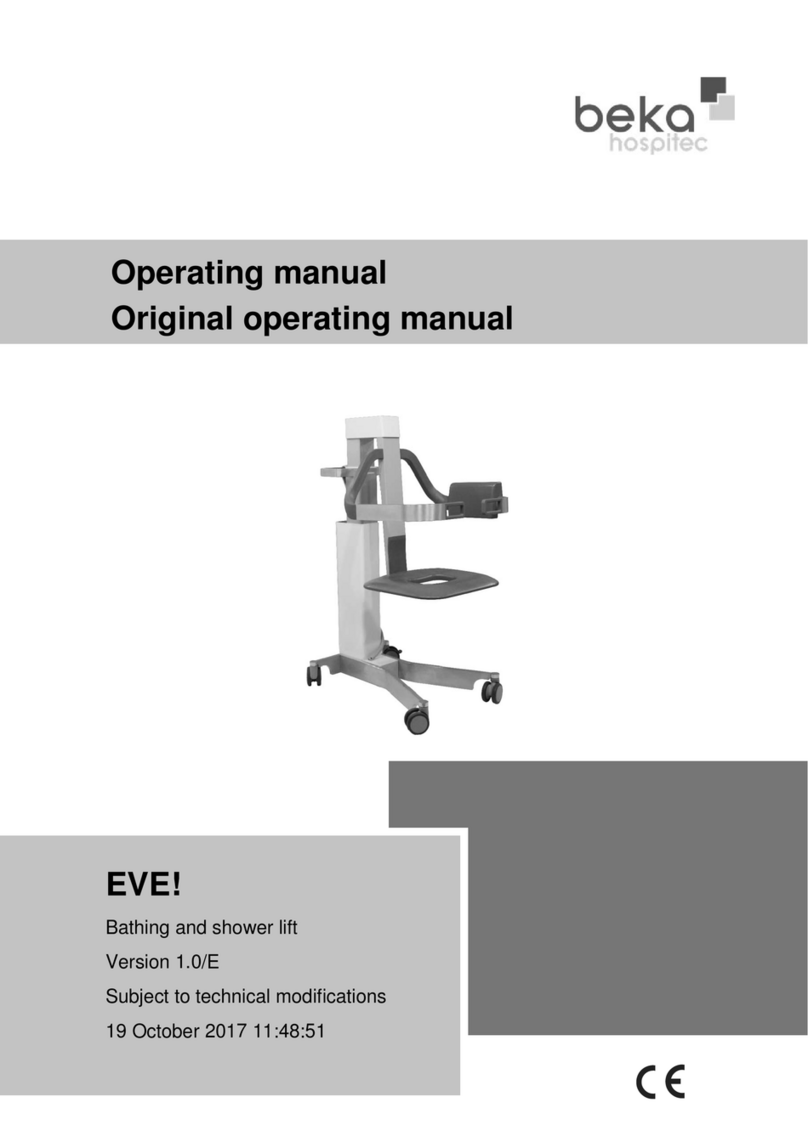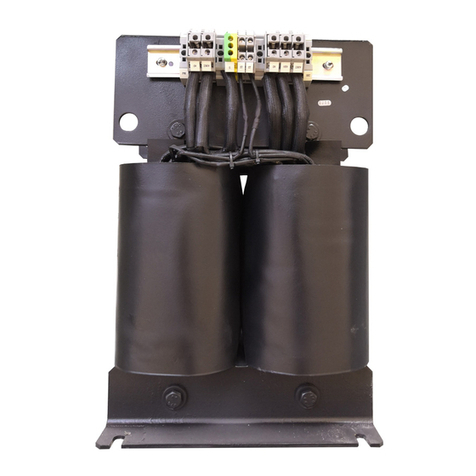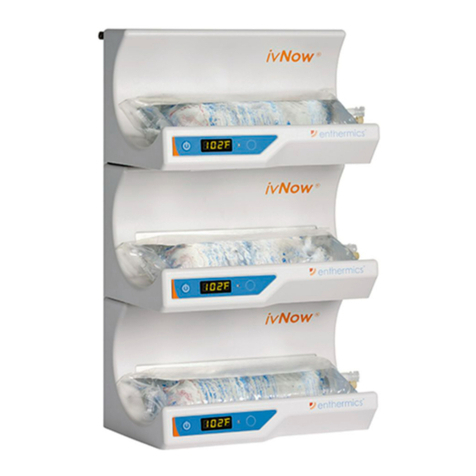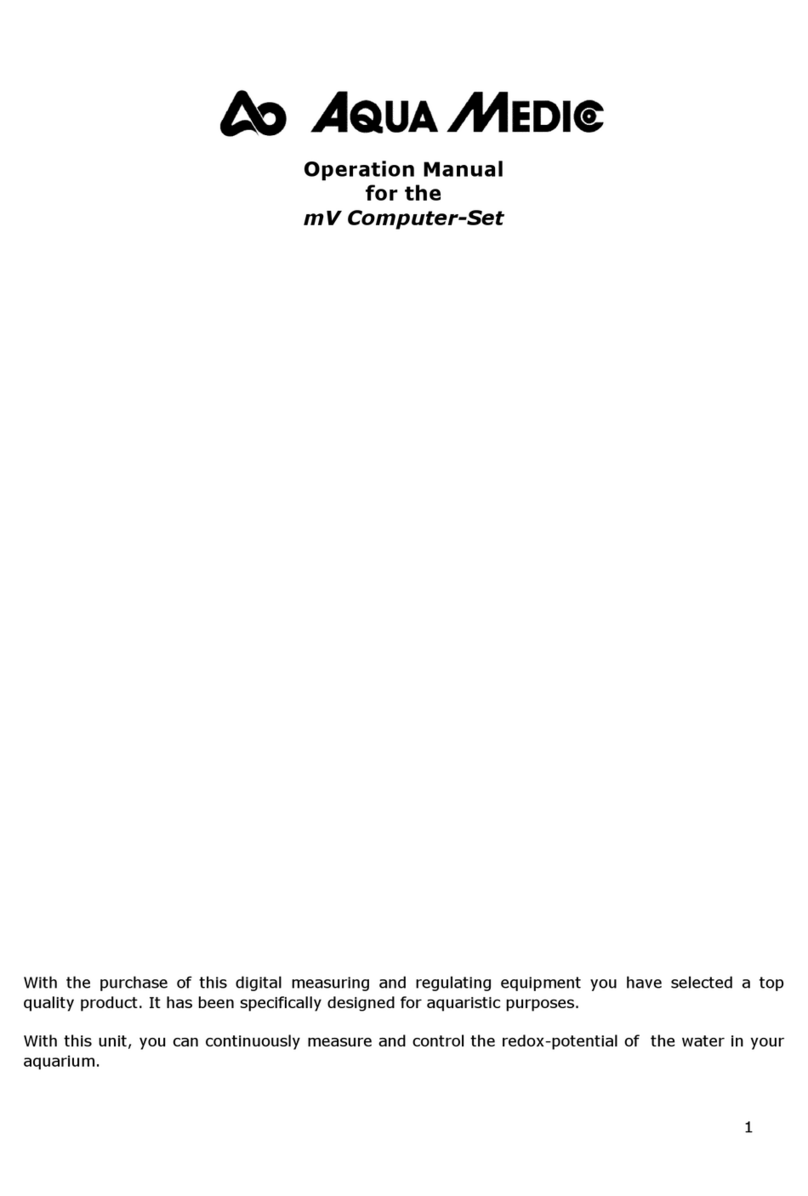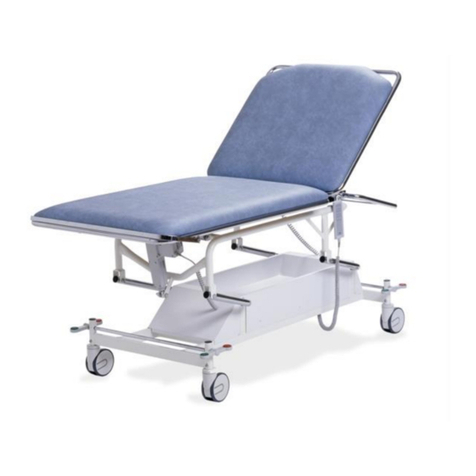Good-Lite 731000 User manual

www.good-lite.com | 1.800.362.3860 | 1.888.362.2576 fax 1
HOTV Near Vision Card
Part Number: 731000
Near vision is functionally more important than distance vision
in the life of a young child. The child is also more accustomed
in using vision at near than at greater distances. Therefore
introduction of the test situation at near familiarizes the child with
the test situation. You learn also about the child’s functional vision:
In the rare case of myopia you will find that the child has useful
vision at near and parents will not be alarmed when the child does
not see well during the distance visual acuity test.
When examining normally sighted children, hold the card at
40cm/16", the length of the cord. Let visually impaired children use
their preferred distance and head posture during the first testing,
later measure at 40cm/16" if the child also uses that distance in
visual tasks.
Testing Procedure
• Establish a method of communication such as naming
(signing) or pointing (matching). When needed, train with
the HOTV Response Panel (#700523), or Flash Cards
(#700515).
• Start with binocular testing, using the center grouping of letters.
• Point to each of the four letters (HOTV) on the top line,
observe the baseline responses for comprehension, speed
and accuracy.
• Cover the top line with a white card (the reverse side of
a flash card may be used). It is best not to cover the top
line completely, but to leave the bottom half of the letters
exposed. (This maintains the “contour interaction” effect of the
standardized chart layout. If this confuses the child, cover the
top line completely.)
• Ask the child to identify only the first letter on the line below
the covering card.
• Repeat this procedure for each or every second line (moving
quickly down the chart to avoid tiring the child) until the child
hesitates or misidentifies a letter.
• Move back up one line and ask the child to identify all the
letters on that line.
• If the child identifies all letters correctly go to the next line
down and ask the child to identify all the letters on that line.
• If the child skips a letter, ask the child to try again while briefly
pointing to that letter.
• The visual acuity is recorded as the last line on which at
least 3 of the 5 letters are read correctly. Always test until the
threshold line.
• If the chart is held at 40cm (16 in) the visual acuity value is
found in the margin adjacent to that line.
• After binocular testing, proceed with testing each eye
separately. When the right eye is covered ask the child to
identify the letters grouped on the lower left of the card (lower
right when the left eye is covered). Use two pairs of plano
glasses for occlusion of the child’s eyes or a pair of symmetric
glasses that can be used for covering both eyes, one at a
time. This is the least disturbing type of occluder for children.
• For monocular testing, follow the same procedure as for
binocular testing.
Monocular near vision testing
Monocular near vision values are important in the follow-up of
amblyopia treatment. Visual acuity values often improve first at
near and later at distance. Before the age of three years it is usually
easier to measure monocular near vision values than distance
visual acuity values.
As a part of vision screening monocular testing is of interest at
the age of 6-7 years. If visual acuity at distance has become less
than it was at age 4 or if there is difference between the two
eyes, near vision measurement may give the following diagnosis:
If the near vision values are symmetric and as before the change
in distance vision cannot be caused by anything else but mild
myopia, which does not need to be corrected. The child does not
need to be referred. This leads to a decrease in the expenses of
vision screening and simultaneously an improvement in the quality
of screening.
Testing Near Vision at Shorter Distances
A child with a visual impairment is allowed to choose any distance
and is given a correction for that distance, if needed. If the chart
is used at a distance other than the usual 40cm (16 in)+, measure
and record the viewing distance and the letter size read (the M
value) or the visual acuity value printed adjacent to the
threshold line.

www.good-lite.com | 1.800.362.3860 | 1.888.362.2576 fax 2
HOTV Near Vision Card
Part Number: 731000
To determine the visual acuity use one of the
following formulas:
Note that it is incorrect to report "V.A. 20/25 at 8 inches" if the
child could read the 20/25-line (.50M line) at 8 inches. Visual acuity
is in that case: 8"/16" x 20/25 = 1/2 x 20/25 = 20/50. (When using
the British notation: 6/9 line at 20cm equals: 20cm/40cm x 6/9 =
1/2 x 6/9 = 6/18. When using the decimal notation 0.8 line at 20cm
equals: 20cm/40cm x 0.8 = 1/2 x 0.8 = 0.4.)
When the distance is one half (or one third) of the standard
distance, the visual acuity value is also one half (one third) of the
value printed next to that line.
If you do not want to do the calculations, report the result as
M-unit value, i.e. in the previous case .50M at 8” (20cm). Visual
acuity is easy to calculate based on these values: VA = 0.2m/.50M
= 2/5=4/10=0.4 or 2/5=20/50 or 2/5=6/15 the closest being
6/18.
The calculation is based on metric measurements. The
corresponding visual acuity values in the American and in the
British notation you can also find on the visual acuity chart. If the
exactly corresponding value is not printed on the chart, calculate
it as follows: For example 0.07= 7/100= [7x3/100x3]=21/300 or
20/300; or for the British notation: 0.07=7/100=6/86 (6x100/7=86)
You multiply both the numerator and the denominator with the
number that makes the numerator equal or closely equal to 20
or 6.
Test Procedure for Mass Preschool Protocal:
50% Crowding Box
1. Point to the child’s left eye and tell the child to close that
eye. Place a patch or other cover over the child’s left eye.
Alternatively, the child or an assistant may use the palm of
his/her hand to completely cover the eye. It is very important
to observe the child carefully to ensure that he/she does
not peek around the hand. Covering the eye with fingers is
not allowed because peeking is too easy with only fingers in
front of the eye. Children with poor vision in one eye are the
ones most likely to peek! If the child persists in peeking, the
child should be referred for a comprehensive eye exam by an
ophthalmologist or optometrist.
2. Move to the wall chart or the location (10 feet from the child)
where the MassVAT flip cards will be presented.
3. If using the MassVAT flip cards, go to the two cards which
correspond to the child’s age. Point to the first letter/symbol
on the R card (for the right eye). Be very careful to point just
below the rectangular box around the letters/symbols. The
pointer (finger or pencil) must not cover the letter/symbol or
extend over the line of the rectangular box, i.e. don’t “break
the box”. Masking, i.e. presenting one letter/symbol at a
time, can overestimate the visual acuity in children with poor
vision. Ask the child to name the letter/symbol or point to the
matching letter/symbol on the lap card. If the child is correct,
point to the second letter/symbol and have the child name or
match it. Continue pointing to the letters/symbols, one at a
time, until the child correctly names at least 4 of the 5 letters/
symbols on the line. If the child misses 2 letters/symbols,
stop there, record the results on the data sheet, and proceed
to testing of the left eye. The child must correctly name or
match 4 of the 5 letters/symbols on the line to pass the test
for that eye. If the child is unable to correctly name or match
at least 4 letters/symbols on a line for each eye, the child
needs to be referred for a comprehensive eye examination
by an ophthalmologist or optometrist. If using a wall chart,
point to one letter/symbol at a time on the line appropriate for
the child’s age. As noted above, be careful not to cover the
surrounding letters or symbols with your finger or pencil
when pointing.
4. After testing of the right eye has been completed, cover the
right eye, and proceed with testing of the left eye. Repeat the
testing procedure by starting with the L card (for the left eye)
if using the MassVAT flip cards. If using the wall chart, point
to the letters or symbols on the appropriate line in a different
order from that used when the right eye was tested, in order
to help prevent memorization.
5. The acuity level required for a child under 4 years of age
to pass is 10/20 (equivalent to 20/40). The acuity level
required for children 4 years of age and older to pass is 10/16
(equivalent to 20/32, with MassVAT) or 10/15 (equivalent to
20/30, with the wall chart)
What You Tell the Child:
1. Keep encouraging the child to respond to your questions.
Urge the child to keep naming or matching the letters/symbols
even if the child must guess.
2. Provide positive comments about the child’s performance,
regardless of whether the child identifies the letter/symbol
correctly or incorrectly.
3. Remind the child to stay seated and look straight ahead at the
flip cards or the wall chart.
4. Repeat the command to keep the eye covered.
What You Write Down:
1. Circle “Pass” or “Refer”.
Other Good-Lite Medical Equipment manuals
Popular Medical Equipment manuals by other brands
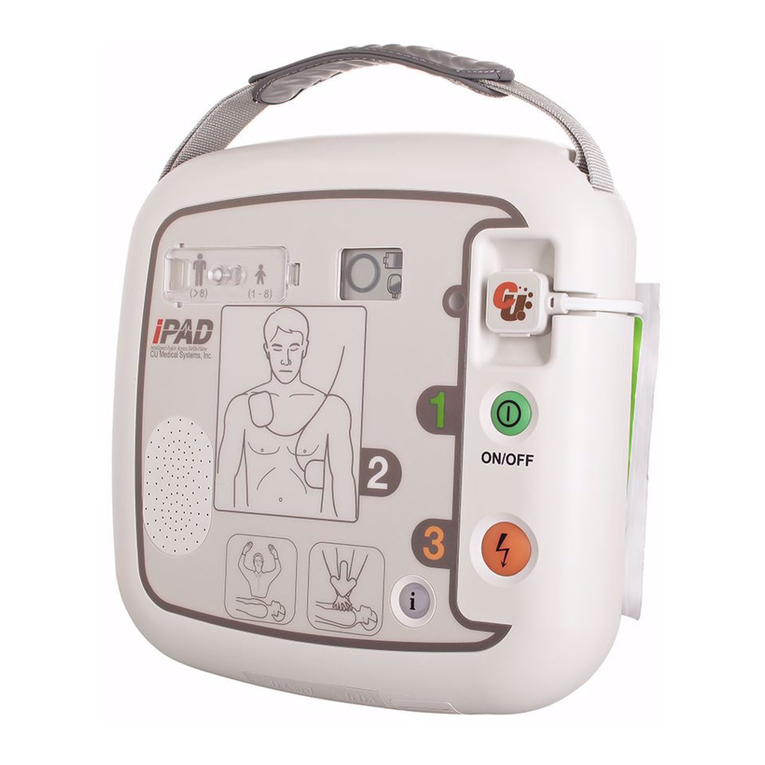
CU Medical Systems
CU Medical Systems iPAD SP1 Operation & Maintenance Policy

Fresenius Medical Care
Fresenius Medical Care DIASAFE 2008 K Technical manual

bort medical
bort medical StabiloBasic Lady Sport Instructions for use
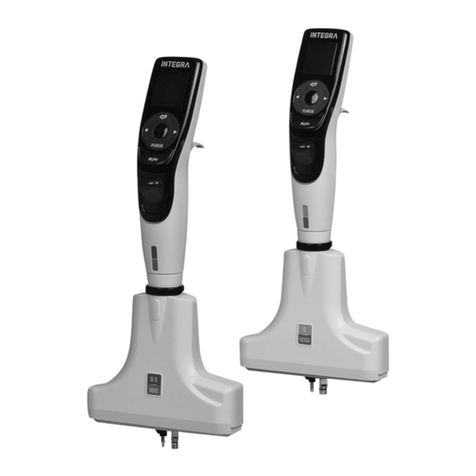
Integra
Integra VIAFLO 4011 VIAFLO 4012 operating instructions
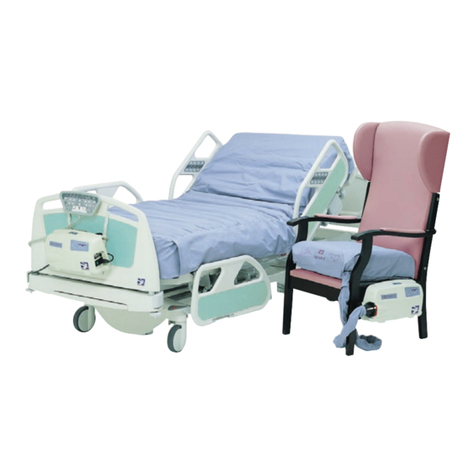
Pegasus
Pegasus TRINOVA Quick reference guide
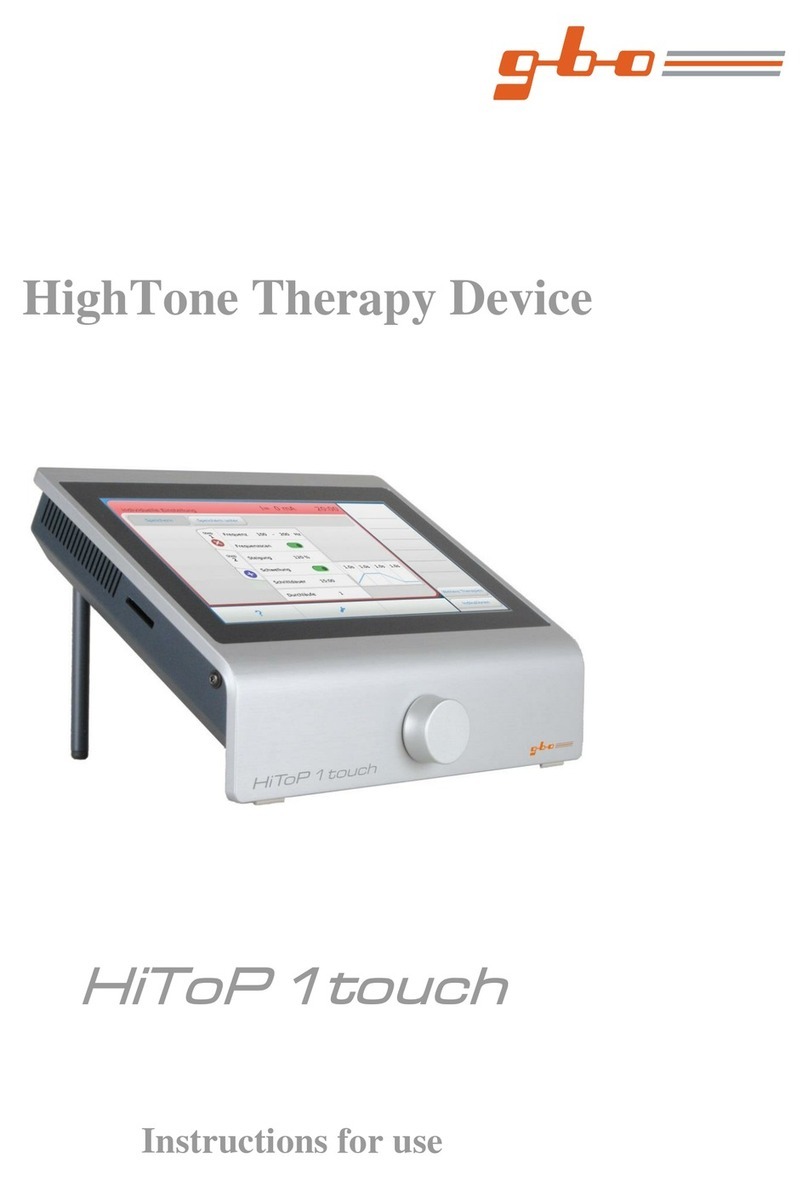
gbo
gbo HiToP 1touch Instructions for use

